Recent Articles
Popular Makes
Body Types
10 Spacious SUVs with the Most Legroom in the Third Row
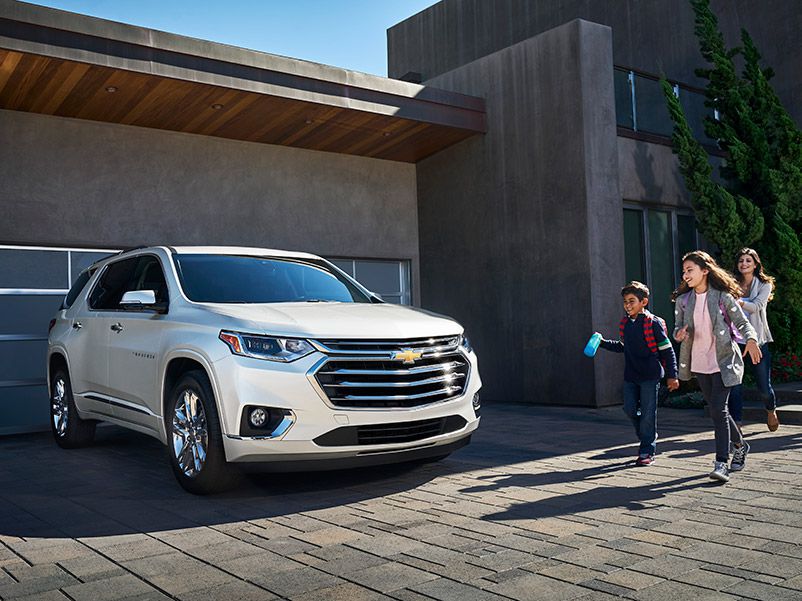
2019 Chevrolet Traverse house ・ Photo by General Motors
Not all third rows are equal. One of the advantages of a big SUV is the inclusion of a third-row seat. But that advantage can be nullified if the third row isn’t sized for your passengers. A pre-teen can squeeze into almost any seat for a short ride, but what if you want to take a long road trip with your teenagers - and they are taller than you?
Thanks to data provided by vehicle manufacturers, we managed to compile our list without breaking out the tape measurers and micrometers. Legroom is the critical dimension in the third row of an SUV, but where available, we’re including headroom, shoulder-room and hip-room measurements as well, so you can estimate whether a third row is going to fit two or three passengers. Here is our list of 10 Spacious SUVs with the Most Legroom in the Third Row.
1) 2019 Ford Expedition – 36.1 inches
If you’re looking for the roomiest third row of all, look no further than the 2019 Ford Expedition. Not only does it have the most third-row legroom of any SUV at 36.1 inches, it also has the most hip room at 51.4 inches and the second-most shoulder room at 64.2 inches (64.3 inches for the long wheelbase Expedition Max model). The only unexceptional dimension in the third row is head room, and that’s more than adequate at 37.3 inches.
Expedition is a body-on-frame SUV based on the same platform as the Ford F-150 pickup truck, so it is a robust vehicle in every sense of the word. Expedition is a worthy passenger vehicle but also can do its part as a towing partner, with the capacity to tow a trailer up to 9,300 lbs (when properly equipped).
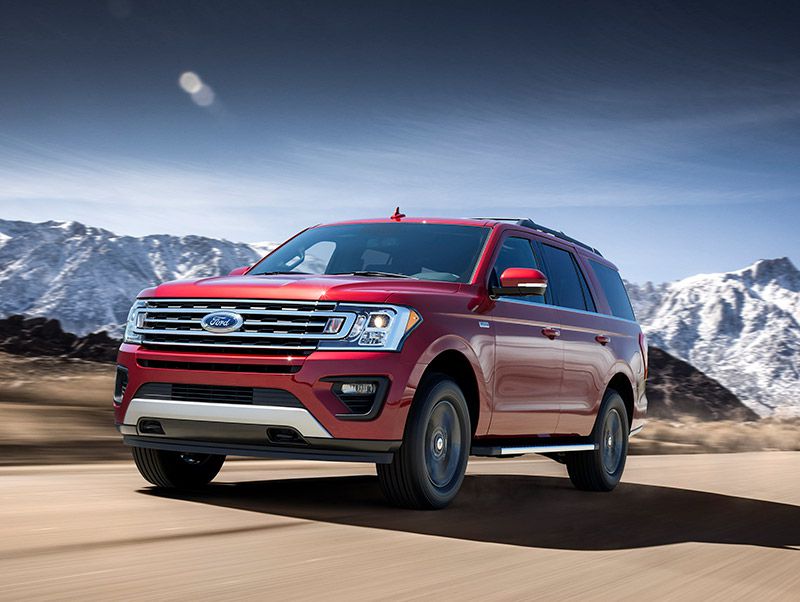
Photo by Ford
2) 2019 Toyota Sequoia – 35.1 inches
Toyota’s largest SUV also has the brand’s most accommodating third row. The 2019 Toyota Sequoia outdoes the Toyota Land Cruiser, Highlander, and 4Runner for third row legroom with 35.3 inches. Not only that, it has the best shoulder room of any SUV with 65.7 inches, and mates that with 50.4 inches of hip room, which means that three average-sized adults can sit in relative comfort.
The Sequoia still comes with a 5.7-liter V8 engine that produces 381 hp and 401 lb-ft of torque, which comes in handy motivating the big body-on-frame SUV that weighs in at just shy of three tons in 4WD configurations. The Sequoia’s maximum payload of 1,405 lbs and towing capacity of 7,400 lbs make a long family road trip with a trailer into a real possibility.

Photo by Toyota
3) 2019 Chevrolet Suburban – 34.5 inches
Many sources point to the 1935 Chevy Suburban as the original SUV. Let the debate rage, but the fact is that the Suburban nameplate is the oldest continuous one still in use in the United States. Its roomy interior, with 34.5 inches of legroom in the third row, certainly contributes to its continued popularity as a family hauler, as well as a fleet vehicle for limousine companies, government agencies, and other executive uses.
It shares traditional body-on-frame platform with the Chevrolet Tahoe, GMC Yukon and Yukon XL, Cadillac Escalade and Escalade ESV SUVs, along with the Chevy Silverado and GMC Sierra pickup trucks in the GM family. The robust construction lends confidence for rugged use, and a cool RST trim level was added in 2018 that includes a high-performance 6.2-liter V8 engine, Magnetic Ride Control suspension, a Borla exhaust, and sporty cosmetic details.

Photo by General Motors
4) 2019 GMC Yukon XL – 34.5 inches
The final in our quartet of traditional body-on-frame SUVs, the 2019 GMC Yukon XL, matches its GM stablemate Chevy Suburban in terms of third-row legroom. The long wheelbase Yukon XL makes use of its stretched frame to accommodate longer legs and more cargo space behind the third row than the standard wheelbase Yukon. Yukon measures out at 24.8 inches of third-row legroom and 15.3 cubic feet of cargo space behind the third row. Meanwhile, Yukon XL can carry 39.3 cubic feet of luggage behind its third row, while allowing third-row passengers 34.5 inches of legroom.
Yukon XL’s ace in the hole is the popular Denali trim level, which pushes the GMC SUV close to the luxury class of vehicles. Yukon XL Denali carries a starting price of $69,500.
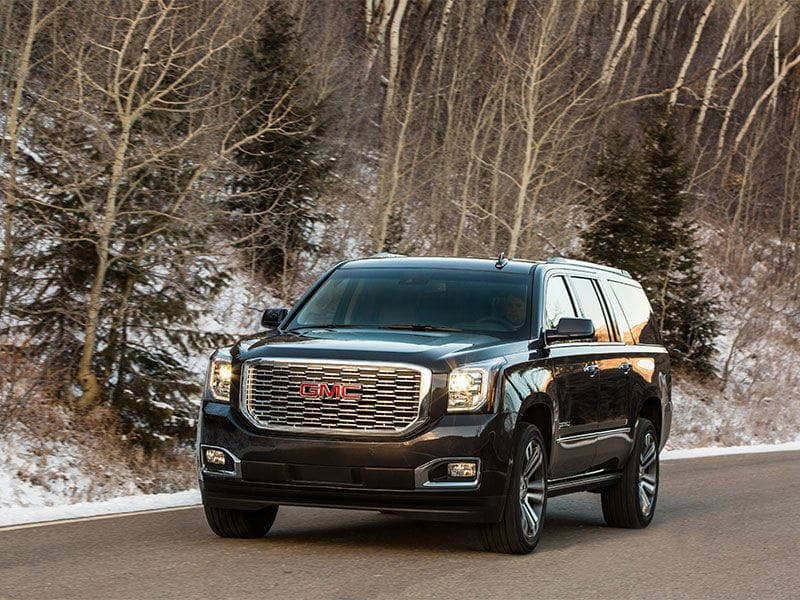
Photo by General Motors
5) 2019 Volkswagen Atlas – 33.7 inches
First introduced as a 2018 model, the 2019 Volkswagen Atlas is the first crossover SUV on our list. It is built on VW’s unibody frameless MQB platform, which also underlies the Passat sedan and several other VW models. With 33.7 inches of legroom in the third row, Atlas is available with a 60/40-split folding bench or with twin captain’s chairs in the second row. With the latter option, access to the third row can be even easier by slipping between the seats, and a very leggy passenger can sit in the center position of the third row and really stretch out.
Atlas is available with a choice of powertrains: a 2.0-liter turbocharged four-cylinder, or a 3.6-liter VR6 direct gasoline injection naturally aspirated (non-turbo) engine. Front-wheel drive is standard, and VW’s 4Motion all-wheel drive system is available with either powertrain.
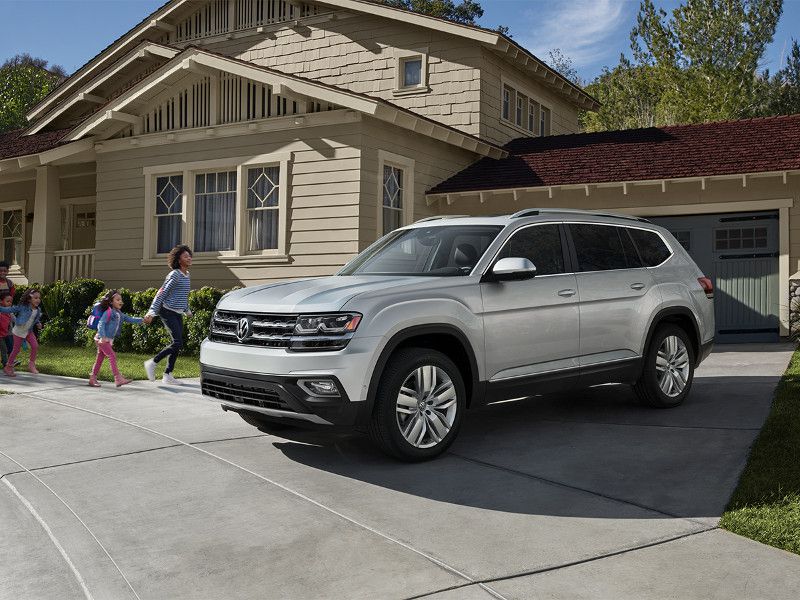
Photo by Volkswagen
6) 2019 Buick Enclave – 33.5 inches
Sharing the Lambda midsize crossover SUV platform with its GM stablemates Chevrolet Traverse and GMC Acadia, the Buick Enclave got a total makeover for the 2018 model year, the first since its introduction as a 2008 model. With 33.5 inches of legroom and 48.5 inches of hip room, Enclave has a genuinely comfortable third row, now more easily accessed thanks to bigger side door openings.
The 2019 Buick Enclave is now available in a premium trim level, Avenir. Buick is hoping that Avenir will be as popular as the Denali trim level has proved to be for GMC, and will spread it to the entire Buick lineup. The base Enclave starts at $40,000; the Enclave Avenir starts at $53,500, and comes with a host of premium features and technologies.
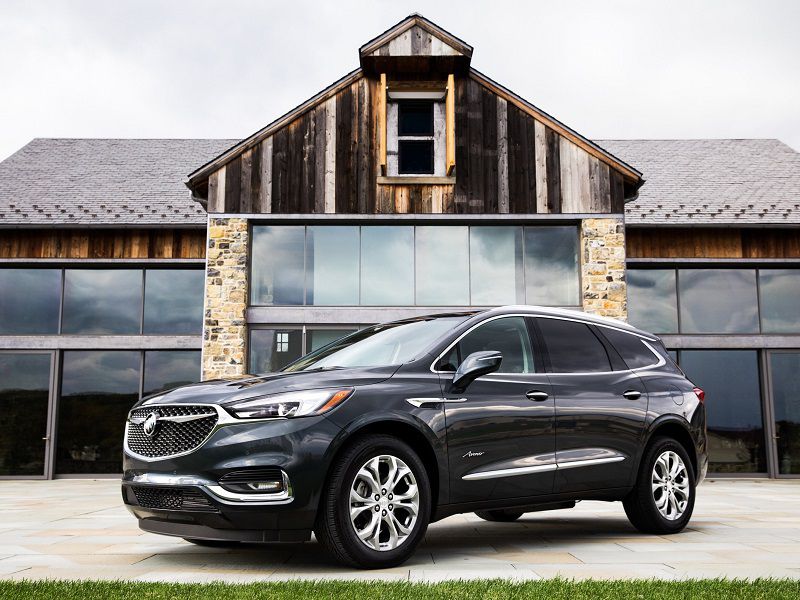
Photo by Buick
7) 2019 Chevrolet Traverse – 33.5 inches
Since it shares a platform with the Buick Enclave, it’s no surprise that the 2019 Chevrolet Traverse also shares a 33.5-inch legroom measurement for its third row of seating. Traverse was all-new for 2018, finally getting a makeover after nine years on the market in its first generation.
A frameless unibody crossover SUV, Traverse has surprising interior dimensions – especially when contrasted with the Chevy Tahoe SUV, a larger vehicle in almost every exterior dimension. Traverse can hold up to 23.0 cubic feet of luggage behind its third row, and up to 58.1 cubic feet of cargo behind its second row, and 98.2 cubic feet behind its first row. In comparison, Tahoe holds 15.1 cubic feet of cargo behind its third row, 51.7 behind its second row, and 94.7 behind its first row.
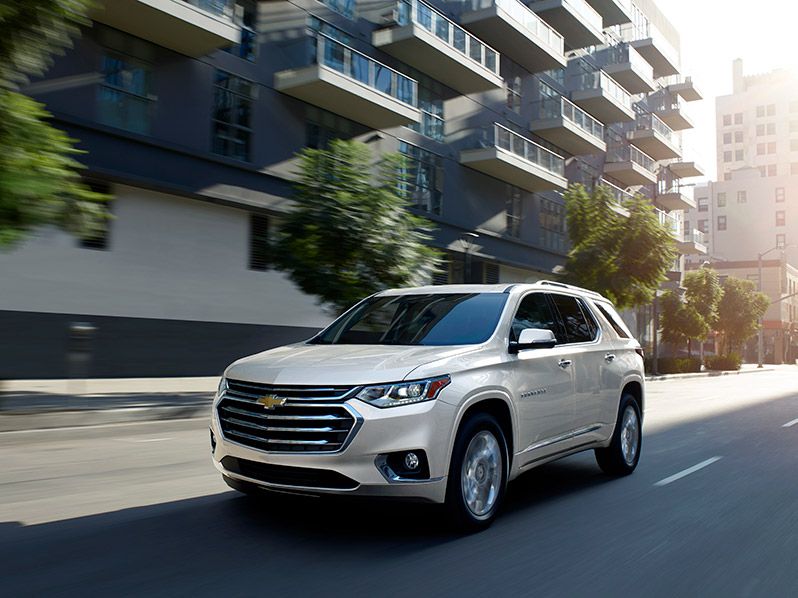
Photo by General Motors
8) 2019 Ford Explorer – 33.3 inches
While the Chevrolet Suburban may claim credit as the first SUV, the Ford Explorer can legitimately take responsibility (or blame, depending on your perspective) for starting the modern wave of SUV popularity. It boomed out of the gate as a traditional body-on-frame SUV in 1991, and was a sales leader through its first four generations. Then, the fifth-generation Explorer appeared as a 2011 model, now riding on a front-wheel-drive unibody crossover platform.
The 2019 Ford Explorer is the final fifth-generation edition, as 2020 will see a new rear-wheel-drive version. While it’s still here, Explorer makes the most of its three-row layout with 33.3 inches of legroom in a comfortable and easily accessible third row. Explorer has been praised for its driving dynamics, and has become a popular service vehicle in law enforcement circles thanks to the available 3.5-liter V6 EcoBoost turbocharged engine and 3.7-liter Cyclone Ti-VCT V6.
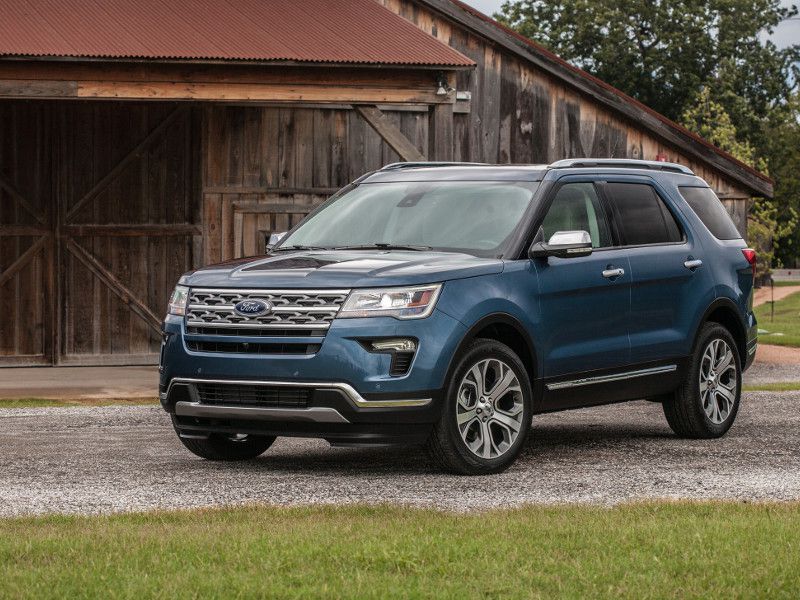
Photo by Ford
9) 2019 Ford Flex – 33.3 inches
With exterior styling inspired by the Woodie station wagons beloved by surfers, the 2019 Ford Flex is one of the most unique-looking midsize crossover SUVs on the market, and has been since its debut as a 2009 model. Flex is the only Ford SUV with a name that doesn’t start with the letter “E,” setting it apart from the Ecosport, Escape, Edge, Explorer, Expedition (and the late Excursion).
With 33.3 inches of third-row legroom, Flex matches the Explorer. Unlike Explorer, Flex has an elegant and tailored dashboard, and an interior that was styled by a designer who had recently arrived at Ford from fashion brand Kenneth Cole. The attention to detail in the cabin is impressive, and has won Flex many fans.
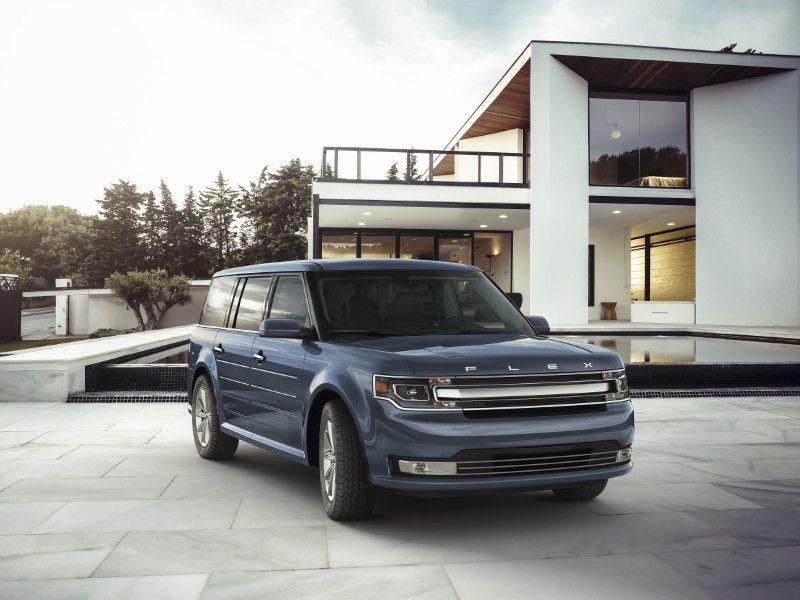
Photo by Ford
10) 2019 Honda Pilot – 31.9 inches
Pilot is Honda’s three-row crossover SUV, which debuted as a 2003 model. It shares a platform and many interior details with the Ridgeline pickup truck. Now in its third generation of production, Pilot received a facelift for the 2019 model year with a new front and rear fascia and some new technology, including a hands-free liftgate.
Pilot’s third row gets 31.9 inches of legroom, so be sure that your passengers will be comfortable before you buy. All trim levels of the 2019 Honda Pilot come with the Honda Sensing suite of driver assistance features as standard equipment, which means that even if your passengers are not quite as comfortable as they might be in some roomier third rows, at least they’ll have the confidence of being protected by a sophisticated safety system.

Photo by Honda